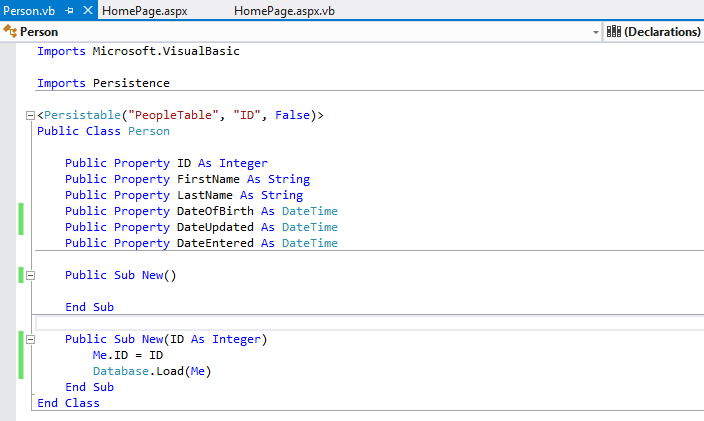You are using an out of date browser. It may not display this or other websites correctly.
You should upgrade or use an alternative browser.
You should upgrade or use an alternative browser.
Why don't we have a simple data persistence interface?
- Thread starter andrewbb
- Start date
- Status
- Not open for further replies.
I think this has everything.
The SQL script creates 5-6 SP's and a SQL function.
To use:
1. using System.Persistence;
2. Connection string called "Persistence" in Web/App.config
3. Attribute on the class: Persistable[table, primaryKey]
That's it.
The SQL script creates 5-6 SP's and a SQL function.
To use:
1. using System.Persistence;
2. Connection string called "Persistence" in Web/App.config
3. Attribute on the class: Persistable[table, primaryKey]
That's it.
Attachments
Last edited by a moderator:
JuggaloBrotha
Staff member
So it's not .Net?15 years ago. 2001.
You claim "No Config" and #2 literally has you using a config, how does that work?I think this has everything.
The SQL script creates 5-6 SP's and a SQL function.
To use:
1. using System.Persistence;
2. Connection string called "Persistence" in Web/App.config
3. Attribute on the class: Persistable[table, primaryKey]
That's it.
The nice thing about the other methods mentioned (DataSet, Entity Framework) is that they support any data source you can have a connection to, but to keep this question simple does yours work with Access database, Oracle, & MySql? Since Access doesn't support SP's, hopefully you have a work around for that, and only the couple of newest versions of MySql support SP's (no functions yet).
It was originally written in Java, ported to VB6, then .NET. It's designed for SQL Server. Plug-ins for Oracle should be simple. It supports direct SQL, so Access and MySql should work, but I didn't design it for Access.
It's designed for serious development of enterprise applications.
It's designed for serious development of enterprise applications.
Last edited:
Herman
Active member
- Joined
- May 5, 2016
- Messages
- 37
- Programming Experience
- 10+
Honestly I don't want to be rude but you don't seem to know what you are talking about... The reason people use ORM's like entity framework is that it has all the features you need to abstract your code from the underlying database. You generate a model of your database and work with the generated entities, which means you have intellisense, type information, navigation properties for foreign keys, change tracking, transactions (and rollbacks), etc... If you decide to port your database to a another database engine, you get its EF-compatible database provider and port the database, and then just regenerate the model. And literally all the config it takes is a model you can generate from an existing database in 5 minutes, and a connection string in your app config, which you need anyway. And what does MySql not supporting SP's have to do with security?
Honestly I don't want to be rude but you don't seem to know what you are talking about... The reason people use ORM's like entity framework is that it has all the features you need to abstract your code from the underlying database. You generate a model of your database and work with the generated entities, which means you have intellisense, type information, navigation properties for foreign keys, change tracking, transactions (and rollbacks), etc... If you decide to port your database to a another database engine, you get its EF-compatible database provider and port the database, and then just regenerate the model. And literally all the config it takes is a model you can generate from an existing database in 5 minutes, and a connection string in your app config, which you need anyway. And what does MySql not supporting SP's have to do with security?
Herman, did you join the thread just to tell me I'm an idiot? You obviously didn't read a word I wrote.
System.Persistence is more secure and easier to use than all other options. It creates a division between data and application.
Last edited:
JuggaloBrotha
Staff member
This advertisement thread has run it's course.
- Status
- Not open for further replies.
Similar threads
- Question
- Replies
- 1
- Views
- 332
- Replies
- 1
- Views
- 583
- Question
- Replies
- 3
- Views
- 243
- Replies
- 9
- Views
- 3K
- Question
- Replies
- 3
- Views
- 766

